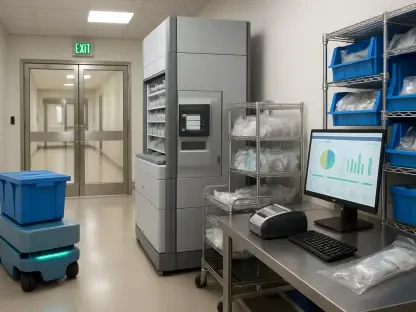In a landscape often marked by heated debates and uncertainties, the healthcare sector has seen a host of significant changes unfold with the enactment of the One Big Beautiful Bill Act. Championed by some and heavily criticized by others, this new legislation presents a contentious shift in the approach to healthcare. Despite widespread criticism, the act harbors potentially transformative provisions aimed at improving healthcare accessibility. One of the Act’s most notable aspects is the enhancement of telehealth services, offering pivotal advances in the way healthcare can be accessed remotely. Amidst the broad rebuke, opportunities to innovate and improve healthcare services present a curious juxtaposition between challenges and forward-thinking elements embedded in the law.
Discovering Opportunities in Telehealth Expansion
Telehealth emerges as a major benefactor in the One Big Beautiful Bill Act, paving the way for improved remote healthcare delivery. By providing first-dollar coverage for telehealth visits to people on high-deductible health plans, the act significantly lowers financial restrictions for millions. This translates to a more seamless experience for patients, alleviating the burden of meeting high deductibles before accessing telehealth services. This element of the legislation supports those holding Health Savings Accounts by maintaining incentives that otherwise might have been threatened. Garnering approval from leading telehealth advocates, such provisions reflect hard-fought victories for expanded digital healthcare.
The shift towards telehealth signifies a broader strategy to make healthcare less burdensome and more cost-effective for patients navigating high-deductible health plans. As private sector workers increasingly enroll in such insurance frameworks, minimizing upfront costs to access healthcare becomes crucial. The new law’s enhancements appear to accommodate this demographic trend, promoting proactive care rooted in digital engagements. Improved telehealth access stands as a key mechanism to dismantle barriers to regular healthcare appointments and preventative services. Additionally, by reducing reliance on costly emergency and inpatient services, telehealth has the potential to drive down healthcare costs system-wide over the long run, improving outcomes and enhancing patient satisfaction.
Addressing Healthcare Gaps through Innovation
The One Big Beautiful Bill Act inadvertently opens doors for private sector employers to creatively fill coverage voids resulting from amendments to ACA provisions. With the erosion of ACA tax credits and changes to Medicaid, a pressing need arises for employers to craft innovative health benefits. This shift challenges companies to redefine health coverage to appeal to a competitive workforce and offset coverage lapses possibly affecting employees. Innovative approaches, such as Individual Coverage Health Reimbursement Arrangements (ICHRAs), grant employers a tool to provide pre-tax financial support for employees to buy personalized insurance, effectively customizing healthcare experiences for individual needs.
Employer-driven innovation under this new healthcare regime suggests a pivot towards personalized wellness programs and extended patient-physician interactions. By adopting primary care subscriptions or directly contracting medical services, companies can tailor benefits packages that resonate with employees, attract talent, and enhance job satisfaction. Thoughtful benefit structures aim to extend care beyond traditional time-constrained consultations, shifting focus towards preventative measures and individualized care plans. Such strategic adjustments promote healthcare continuity, aligning with broader employee wellness goals and fostering an adaptive response to the abrupt gap introduced by the legislation’s changes.
Strengthening Domestic Medical Manufacturing
A significant—but often overshadowed—component of the One Big Beautiful Bill Act is the reinforcement of domestic medical manufacturing. At its core, the legislation provides a framework designed to boost U.S. manufacturing capabilities in medical supplies and equipment, viewed as a victory amidst controversial measures. The act introduces tax incentives aimed at fostering capital investments and research within the domestic sector, crucially focusing on the national stockpile of necessary medical equipment. Recognizing challenges posed by international subsidies, the bill seeks to create a level playing field for U.S.-based manufacturers contributing to medical supplies.
Tax incentives, allowing deductions for investment in new manufacturing infrastructure and R&D expenses, are devised to make this sector more competitive against global players. Such provisions empower manufacturers to immediately deduct machinery costs, facilitating equipment upgrades and innovation. Moreover, removing federal tax on overtime earnings provides a dual benefit of encouraging greater production output while offering financial stability for domestic workers. Ultimately, the bill’s focus on medical manufacturing positions it as a pivotal piece in fortifying production autonomy, with potential long-term benefits for the U.S. economy and healthcare supply chains.
Fostering Pharmaceutical Research and Development
Beyond healthcare delivery, the One Big Beautiful Bill Act also aims to uplift the pharmaceutical industry’s foundation, providing key financial reprieves. By reversing certain detriments introduced by prior tax cuts, the act allows pharmaceutical companies to expedite research and development stages by fully expensing R&D within the same fiscal year it incurs. This reform liberates financial constraints for biotechnology firms developing innovative therapies, strengthening their financial viability and enabling quicker advancement through drug development pipelines. It’s a move aimed at spurring innovation at all stages, from initial research to the final market introduction.
Importantly, the legislation provides shelter to therapies labeled under orphan drug designations from federal price negotiation regulations. These are drugs aimed at treating rare diseases, markets often overlooked due to limited commercial appeal. By insulating these critical drugs from pricing debates, the act offers stability for investors and researchers invested in rare disease therapies. Such provisions reflect an appreciation for the unique challenges encountered by niche pharmaceutical ventures, ensuring they continue to contribute meaningfully to medical advancements without facing aggressive pricing constraints imposed by larger market healthcare policies.
Conclusion: Navigating Opportunities Amidst Challenges
In a landscape marked by frequent debates and uncertainties, the healthcare sector is witnessing momentous changes with the introduction of the One Big Beautiful Bill Act. This legislation is divisive, praised by some and critiqued by others, as it represents a significant shift in the healthcare approach. Critics are vocal, yet the act holds provisions that could potentially reform healthcare accessibility. One of the standout features is the enhancement of telehealth services, which promises pivotal improvements in remote access to healthcare. Despite substantial opposition, the act offers prospects for innovation, contrasting the unfolding challenges with progressive elements within the law. It brings both obstacles and unrealized potential, providing an intriguing interplay between existing healthcare issues and novel solutions. As debates persist, stakeholders are at a crossroads, weighing transformative change against long-standing conventions. This legislation stands as a testament to the ongoing evolution and complexity of healthcare policy-making today.









